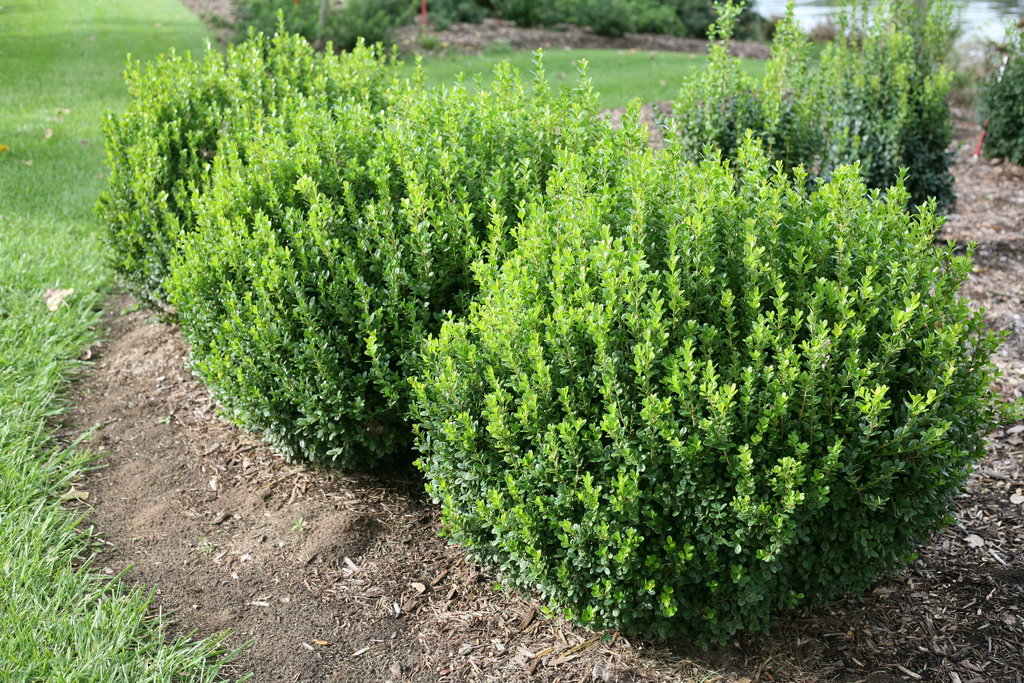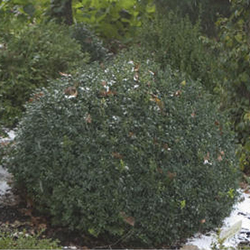Boxwood - The Ultimate Growing Guide from Proven Winners®
Boxwood (Buxus spp.) is one of the most popular and versatile garden shrubs, providing year-round structure and color in the landscape.
Buy boxwood shrubs – Order online and have them shipped right to your door
From grand country estates to small urban lots, boxwood evergreen shrubs have played an integral role in landscapes across the globe for hundreds of years. What makes this widely used plant so valuable is the ease of growing, year-round interest, tolerance of different growing conditions, and versatility in the landscape. Boxwood is deer resistant with good cold hardiness, making it a viable choice for many different regions. 
Boxwood varieties come in a range of shapes including rounded, upright, pyramidal or spreading, with sizes ranging from 1-20 feet tall and 2-8 feet wide, depending on the variety. Boxwood hardiness zone is generally from 5-9, though a few cultivars are hardy to zone 4.
The types of boxwood most often used in home gardens include dwarf and variegated varieties of English boxwood, Japanese boxwood, Korean boxwood and American boxwood (not native to North America). The dense fine foliage in shades of green or gold variegation is highly amenable to shearing, making them ideal for formal hedging and topiaries.
PLANTING & BOXWOOD CARE
Where to plant: When planting boxwoods, choose a wind-sheltered site with partial or dappled shade that receives at least 4-6 hours of direct sunlight, with protection from hot afternoon sun. Boxwood can grow in full shade (less than four hours of light/day), however, they tend to take a more open habit, and leaf color may be impacted.
How to plant: For hedging, space plants at half their mature width; for example, if the mature width is 4 feet, space plants with their centers 2 feet apart. For stand-alone specimens, allow more space around plants for good air circulation. Follow these steps to plant boxwood.
- Loosen soil in the planting area and dig a hole twice as wide and slightly deeper than the root ball.
- Remove the plant from the nursery pot and tease out roots if potbound.
- Set the plant in the hole with the crown slightly above soil level. This will allow for settling and help keep the roots from sitting in water, which can stress or kill plants.
- Backfill the hole with soil and tamp down slightly to remove air pockets. Water well.
Related: How to Plant a Shrub
Soil: Boxwood shrubs are adaptable to different soil types as long as there is good drainage. Mulch with a layer of shredded bark to suppress weeds, retain moisture and keep the root zone cool. For containers, use a high-quality potting mix.
Watering: When plants are young, keep soil evenly moist but not soggy. Plants may suffer from root rot if they are overwatered or if the soil drains poorly. Since they are shallow-rooted, they will need more frequent watering during hot, dry spells, or when planted in containers. Irrigate in the morning and avoid overhead watering to help prevent boxwood blight.
Fertilizing: Use an all-purpose fertilizer or one formulated for trees and shrubs. Apply in spring to promote foliar growth.
Pruning: The small leaves and dense growth habit make boxwoods especially amenable to shearing into formal hedging and topiaries. Lightly trim plants to shape as needed and cut out any broken, dead or diseased branches. If outer growth becomes too dense, selectively remove some of the older branches to improve air circulation and allow more light.
TRY THESE PROVEN WINNERS® VARIETIES
Try these varieties in your landscape:
 North Star® (Buxus sempervirens) is a cold hardy medium-sized variety that forms a symmetrical globe of dense green foliage. Train into a low hedge, or use in formal plantings. Tolerant of heavy pruning. |
 Sprinter® (Buxus microphylla) is an improved form of ‘Winter Gem’, with glossy evergreen foliage and excellent winter hardiness. The faster growth rate and upright habit makes this a good choice for hedging. Use in foundation plantings, containers or as low hedging in a formal garden. |
BOXWOOD FAQ’s
Do boxwoods like sun or shade?
Boxwood prefers partial or dappled shade, with at least 4-6 hours of direct sun per day. Provide protection from hot afternoon sun.
How tall do boxwoods get?
Dwarf types can grow to just 1-foot-tall, while the largest varieties reach up to 20 feet tall.
Are boxwoods fast growing?
Boxwoods are slow growing compared to many other shrubs, with growth rate depending on the variety. Dwarf types may only see 1/2-1 inch of new growth per year, while the typical growth rate for most varieties is 3-6 inches per year.
What are boxwoods good for?
This versatile shrub has many uses, as privacy screening, pathway edging, to divide garden rooms, as container specimens, in mixed borders and foundation plantings, as topiaries, or a stand-alone specimen in the landscape.
Are boxwood shrubs easy to maintain?
When planted correctly and given proper care, these forgiving shrubs need little attention once established. Well-drained soils, protection of the shallow root system, and shelter from winter wind and cold extremes are essential for healthy plants, and to deter pests such as leaf miner.
When to trim boxwoods?
Boxwoods can be pruned at nearly any time during the growing season. Avoid pruning in late fall or winter to prevent cold damage.
What to plant in front of boxwoods?
Use the neutral green backdrop of boxwood shrubs to set off colorful perennials, annual bedding plants, bulbs, dwarf conifers or deciduous flowering shrubs such as hydrangea or spirea.
Why are the leaves on my boxwood turning yellow?
Yellow leaves are one of the most common problems in boxwood. This can be due to several factors, including root rot, drought stress, nematode pests or damage from winter cold.
HOW TO USE BOXWOOD IN YOUR LANDSCAPE
The versatility of boxwood makes it an invaluable addition to any landscape. Here are just a few ideas on how to add these classic shrubs to your yard.
- Create a symmetrical arrangement of low boxwood hedging as the framework for a formal garden.
- Plant two small to medium-sized specimens in large decorative containers and place on either side of your home’s front door for a welcoming year-round display. Adorn with tiny twinkling lights in winter for festive holiday cheer.
- Use small to medium-sized boxwoods in a foundation planting, by themselves or in combination with other plants. Vary the sizes and shapes for a more captivating effect.
- Outline outdoor garden rooms with small or medium varieties planted as hedging. For a more formal look, keep plants neatly sheared.
- Edge a pathway with a low-growing hedge to accentuate the hardscape.
- Train any sized boxwood plant into a spiral or other shape of topiary as an engaging focal point in a container or the landscape.
- Add year-round color and structure to a mixed border with varieties in different shapes and sizes.
- Soften the area in front of a fence or wall with hedging or individual specimens to provide contrast and visual interest.
- Define the front of garden beds with low boxwood hedging.
- Use low-growing types as hedging to define rose beds.
COMPANION PLANTS
Plant boxwood in combination with other plants with similar cultural needs of full sun to partial shade and good drainage.
For a cheerful springtime display, plant with:
- Perfecto Mundo® Double Purple reblooming azalea
- Baby Kim® lilac
- Wedding Party® Confetti Cake lenten rose
- Miss Piggy Pigsqueak bergenia
For a foundation planting, pair with other shrubs such as:
- Fine Wine® weigela
- Happy Face® Pink Paradise potentilla
- Soft Serve® Gold false cypress
- Oso Easy Peasy® rose
For a semi-shaded woodland border, plant alongside:
- Gatsby Pink® oakleaf hydrangea
- Shadowland® ‘Seducer’ hosta
- ‘Pink Diamonds’ fern-leaved bleeding heart
- ‘Vision in Red’ Chinese astilbe




